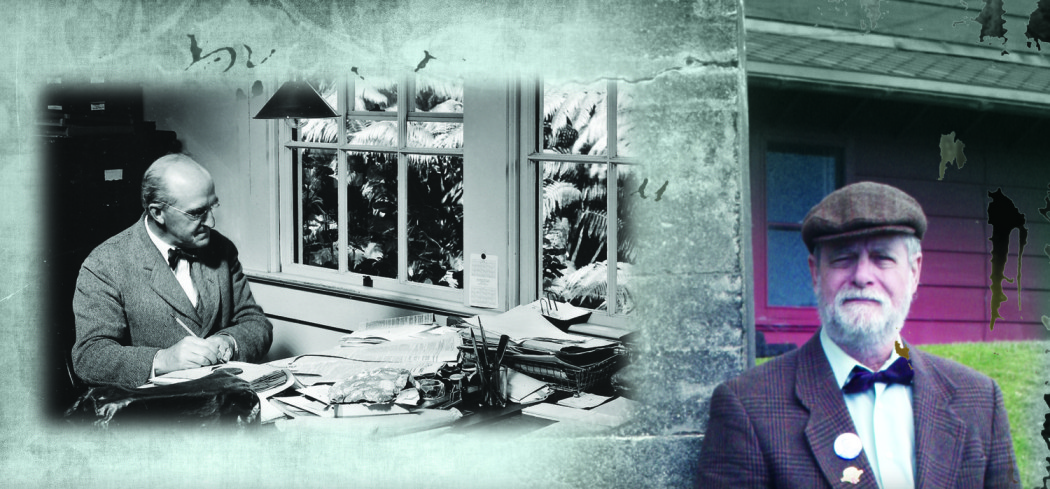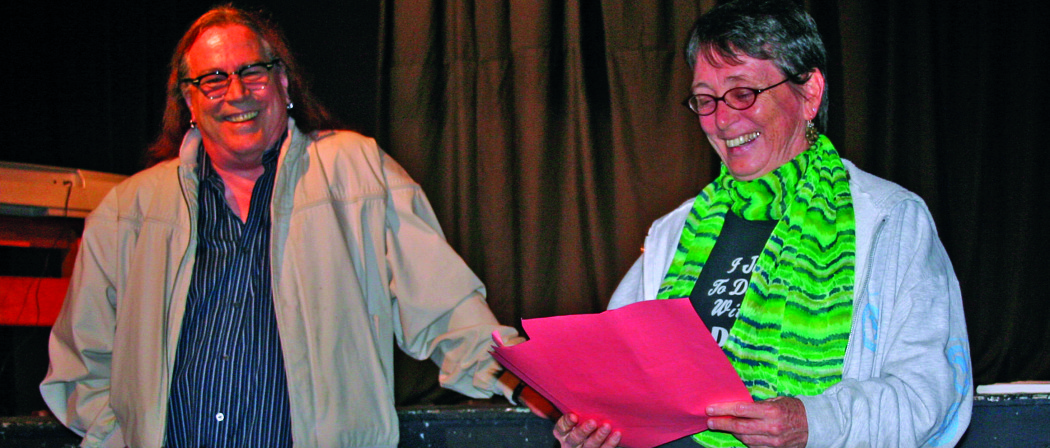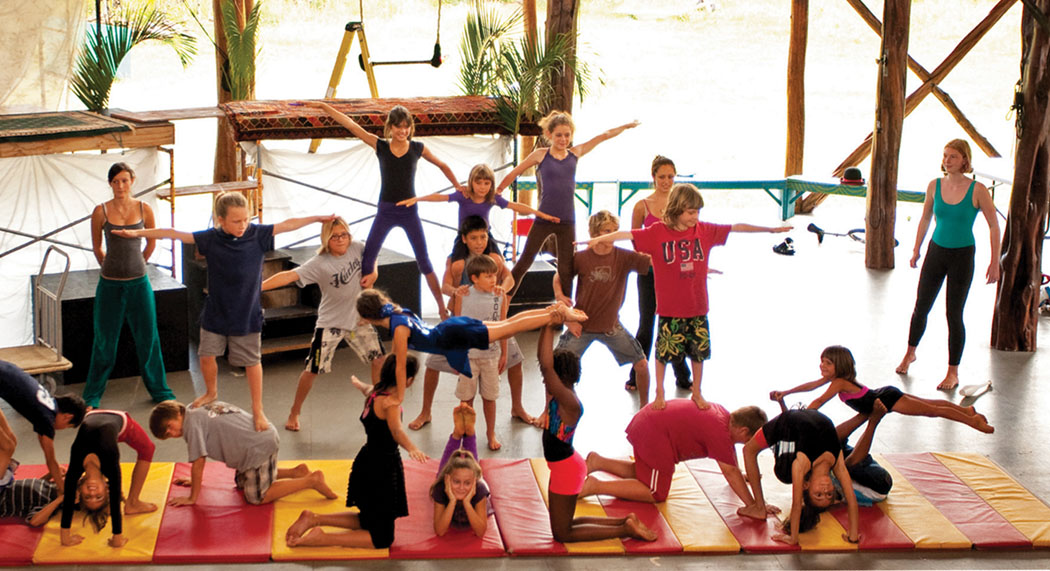
A Victorian-Age Indiana Jones: Actor Peter Charlot as Professor Jaggar, Intrepid Scientist/Adventurer
 By Alan D. McNarie
By Alan D. McNarie
The gray-haired figure stands on the side of a green mound next to the empty Volcano house in Hawai‘i Volcanoes National Park.
“I’m Professor Jaggar,” he tells the group of visitors, “and we’re here to save people’s lives.”
Professor Jaggar is actually Volcano playwright and actor Peter Charlot, who comes to the park once a month, dons a period suit and tweed cap, and transforms into the founder of Hawaiian Volcano Observatory (HVO): Victorian-era geologist Thomas A. Jaggar. The green mound covers the Whitney Vault, which sheltered the Observatory’s first seismometer from the rumble of wagons and carriages. Charlot, in persona, with the help of Elizabeth Maydwell, (played by Sandra MacLees), Jaggar’s assistant and future wife, leads visitors on a tour of the vault in a “living history” reenactment. The visitors themselves become actors in the improvisational play, pretending they’ve just arrived at Volcano House after journeying by boat, train and carriage in April of 1912. The performance is sponsored by the Kīlauea Drama and Entertainment Network (KDEN) with the help of various grants; KDEN just secured funding to ensure that Professor Jaggar will continue to appear throughout 2012, which marks the 100th anniversary of the observatory’s founding.
Charlot studied the scientist’s life and writings intensively to generate the portrait which is far from the usual dry image of a scientist. A tough, wiry man with bushy eyebrows and a balding pate, he impressed visitors with what Charlot dryly calls his “sartorial sophistication”—period photos show him wrestling heavy equipment on a lava flow while wearing a dress shirt, neck tie and beret. HVO’s founder was also a gifted amateur actor and magician: as a college thespian, he once appeared on stage with Sarah Bernhardt, the diva of her age, and, Charlot notes, “He was well known for pulling eggs out of children’s ears.” Jaggar was a (very bad) poet, a Red Sox fan, a Bull Moose Party supporter and a prolific inventor, creating an amphibious vehicle that became the prototype for the World War I DUCKW. Even as something of a lady’s man, he was, above all, a prime example of that dying breed, the Victorian scientist/adventurer.
“He was very much the assertive, highly intellectual, perhaps slightly nasty character combined with this very human theater player,” Charlot says.
The story of Jaggar and Hawaiian Volcano Observatory really starts on another island, Martinique, in the Caribbean. Jaggar, then a 31-year-old Harvard geology instructor, and four other scientists disembarked at a wilderness of loose stones and charred pink plaster that, only a few days before, had been the island’s capitol, Sainte-Pierre. A volcano named Mt. Pelée had sent a pyroclastic flow—a red-hot cloud of ash, steam and gas—roaring through the city, cooking to death all but three of its 38,000 inhabitants. Jaggar/Charlot recalls to his audience that he was surprised to see smoke still rising from the city, and was told, “It’s not the burning of buildings; it’s the burning of bodies.”
“When I realized that I’d been spending my time enjoying the camaraderie of the journalists and scientists aboard ship, and not thinking about where I was going….when I realized that I was seeing the fires of burning bodies, I was deeply embarrassed,” he tells the visitors. “That moment became a cathartic transformation. My entire career changed, because I found out that I’d been spending my time teaching rich, young Harvard men about rocks, but I found that saving lives was my vocation.”
It would be ten years, however, before that transformation was complete. In the interim, Jaggar became Chair of Geology at MIT, even though he was often gone on expeditions to volcanoes in Europe, Alaska, Japan and the Caribbean. In Italy, he became friends with a former electrical engineer and inventor named Frank Alvord Perret, who’d applied his electrical expertise to create instruments for monitoring Vesuvius. In Japan, he met another kindred soul, Professor Omori Fusakichi of Imperial University, who’d founded the first extensive earthquake detection network and invented the most advanced earthquake detector, or seismometer, of the day. Perret had strung specially designed microphones around Vesuvius to listen for the vibrations of lava traveling toward the surface. But Omori had found a way to make those vibrations visible, even when they were too tiny to be felt by human senses.
Sitting in the Whitney Vault, along with many instruments left there since Jaggar’s day, is a reproduction of one of Omori’s seismometers. Two 250-pound cylindrical weights hang suspended by piano wire from massive iron posts that are anchored, through a cement pedestal, to the bedrock below. Projecting from each cylinder is a long, triangular arm with a phonograph-like needle that barely touches a role of smoked paper on a slowly rotating drum.
Charlot’s Jaggar tells visitors, “There are three things I want you to remember. First, vote for Teddy Roosevelt.” (In 1912, Roosevelt, dissatisfied with the presidential performance of his protégé, Howard Taft, formed his own “Bull Moose Party” for another run on the White House. He didn’t succeed, but split the vote enough to allow Democrat Woodrow Wilson to win.) Second, “The Boston Red Sox are going to win this year.” And third, “The needle doesn’t go back and forth over the drum. The drum goes back and forth under the needle.” When an earthquake happens, the inertia of the hanging cylinders holds the needle still, but the moving drum, also anchored to the bedrock, vibrates with the earth, tracing a jagged line in the carbon atop the paper. The instrument is so sensitive that a child jumping up and down next to it can make the needle dance—or rather, the earth dance under the needle.
In 1909, on his way to Japan, Jaggar stopped off in Hawai‘i and saw the seething lava lake that then filled Halema‘uma‘u, the “house of everlasting fire.” Here was the ideal volcano to study, he thought: comparatively safe, almost continuously active, fairly accessible, and in an American territory. A firm believer in Manifest Destiny, Jaggar had little sympathy for those who sought to restore the Hawaiian kingdom. In Honolulu, he spoke to the Chamber of Commerce about the possibility of a geophysical observatory at Kīlauea, finding an instant and enduring ally in Lorrin Thurston, one of the chief conspirators in the 1893 overthrow. Thurston owned the railroad that ran halfway to Kīlauea’s Summit and a majority share in the Volcano House Hotel.
Back in Boston, it took Jaggar a year to convince university officials and the Whitney Foundation to invest in his Kīlauea dream. The pregnancy of his wife, Helen, would keep him stateside another year. It wasn’t until January of 1912 that Jaggar finally reached Kīlauea. Perret, who had arrived the year before with the Thurston family, had installed three special high-temperature thermometers funded by Whitney money; he’d burnt up two of them before successfully taking the temperature of lava for the first time. With the help of territorial convict labor, Jaggar dug out the Whitney Vault and installed his Omori-designed, German-built seismometers.
But as important as his equipment, Jaggar/Charlot recounts in the vault, was the idea of “the first scientific laboratory on earth that is designed for the saving of human life.” Jaggar knew that volcanological expeditions, in the past, had only been dispatched after an eruption was underway. But if he was going to prevent another Sainte-Pierre, he had to know what happened before an eruption—and then establish other watch posts to look for those warning signs at other volcanoes.
“I want observatories around the world…just like this one, that communicate with each other via telegraphy,” Charlot says, channeling Jaggar. The real Jaggar, before his death in 1956, would establish such observatories at Mt. Lassen in the Cascades and the Aleutian Islands in Alaska, in addition to Hawai’i.
“He wasn’t the first-class mind of an Isaac Newton, though he had a first-class idea in the global system of monitoring the earth,” believes Charlot.
That brilliant scientific dream nearly came undone, thanks to human foibles. When Helen came out to join her husband, she apparently discovered that he’d been having an affair. The Jaggars’ marriage had never been an easy alliance, anyway. Helen, the daughter of a banker with connections in Boston’s high society, would have been the ideal mate for a rising college professor. Jaggar, unfortunately, wasn’t an ideal college professor. Charlot compares him to Indiana Jones.
“He did not like colleges. He did not like academia,” says Charlot. “He had a lifelong antipathy for it.”
Nor, probably, was Helen cut out for life on the edge of a volcano, affair or not. She got a divorce—almost unheard of in her circle in those days—and went back to Boston, where her tale met sympathetic ears. Scientific historian John Dvorak, who served as one of Charlot’s mentors for the show, wrote in an article in Physics Today that three years after arriving at Kīlauea, “Jaggar was notified that “MIT would soon disassociate itself entirely from the project, in part due to rumors of Jaggar’s ‘domestic infelicities and allied troubles.’” But Thurston and his Honolulu friends came to the observatory’s financial rescue, and it eventually gained the sponsorship of the U.S. Geological Survey.
Meanwhile, Jaggar’s ideas were bearing fruit. Dvorak notes that in 1914, after Jaggar’s seismometers detected a swarm of tiny earthquakes on Mauna Loa, he predicted an eruption—and it happened. His use of tiltmeters to record the inflation of a volcano’s crust as its magma chamber filled became recognized world-wide as a valid tool for anticipating eruptions. In 1933, after his seismometers detected an earthquake in Japan, he made the first accurate prediction of a tsunami.
His social life was also improving, thanks to Ms. Maydwell. The California widow and the volcanologist had lively differences on a wide range of topics, from spirituality to native Hawaiian rights to women’s suffrage, topics which Charlot and MacLees have great fun with in the vault performance. She quickly proved to be as tough and adventurous as he was, and, Dvorak noted, as capable of reading a seismometer.
“They’re a perfect couple. She loves the volcano, and there are lots of pictures of them climbing and hiking together on the volcano,” Charlot says. They married in 1917, and she moved into the house Jaggar had built on the edge of the caldera (it’s since fallen in), which they shared with a monkey named Wally, after Wallace Simpson, the American divorcee for whom Britain’s King Edward VIII gave up his throne. The Jaggars also bought land in Kona, where he became active in the local community theater.
Charlot’s path first became entwined with Jaggar’s 25 years ago, when Volcano Art Center commissioned him to do a play about Jaggar entitled “The Vision of a Scientific Missionary,” to commemorate the observatory’s 75th anniversary.
In many ways, Charlot is as much an antithesis of Jaggar as Maydwell was. Low-key and easy-going, he takes the opposite view from the scientist on many political issues—he’s a long-time supporter of Hawaiian sovereignty, for instance. The son of famed artist Jean Charlot, he moved with his family from Mexico to Honolulu when he was two years old and spent his childhood learning to “jump through the hoops” to be accepted as local. He made a name for himself as a writer of Hawaiian historical dramas on such themes as Queen Ka‘ahumanu and the Battle of Kuamo‘o, but as the sovereignty movement gained momentum, he found it more and more difficult for a haole, even a haole with his credentials, to be accepted as a playwright on Hawaiian themes.
“With a show like this, I’m staying under the radar,” he says. “I’m doing rather controversial work, talking about Lorrin Thurston and Manifest Destiny—the patronizing feelings that people had toward the Hawaiians.” Despite his differences with the flamboyant scientist, Charlot can also admire Jaggar’s vision.
“In Jaggar’s mind, the earth was a living organism,” he says. “It was alive, and it behaved in such a manner as we behaved.” ❖
Contact writer Alan D. McNarie at amcnarie@yahoo.com.


